-
Walk this way
When there is such a wide selection of travel destinations, why should one opt to go on a pilgrimage?
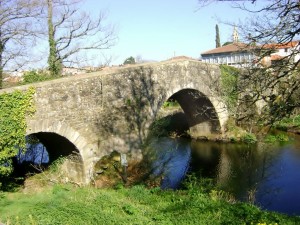 “I did ask that question to myself on the first day of my Camino,” revealed Matthias Ebejer. “The walk to Santiago de Compostela in northwest Spain is not a travel holiday like many others. It can be quite a shock for those who are not used to outdoor activities such as hiking, trekking or camping. On the other hand, it can prove to be pretty challenging to find the real meaning of it all if one is regularly accustomed to such adventures.”
“I did ask that question to myself on the first day of my Camino,” revealed Matthias Ebejer. “The walk to Santiago de Compostela in northwest Spain is not a travel holiday like many others. It can be quite a shock for those who are not used to outdoor activities such as hiking, trekking or camping. On the other hand, it can prove to be pretty challenging to find the real meaning of it all if one is regularly accustomed to such adventures.”Matthias was definitely not one of the latter. He was enticed to go on this pilgrimage by his girlfriend Deborah since she had already experienced it together with her family.
“It did not take her much to convince me. As I began to look for information about this walk, I realized that this was the perfect way to get to know Spain closely. Such a pilgrimage gives you the opportunity to walk from one village to another, crossing different regions, meeting all sorts of people and learning about their culture and the places’s history. It is also very interesting to observe the changing architectural styles, cuisine forms, and people’s mentalities as you move along the rural areas which turn into urban locations as you get closer to the final destination.”
 As a historian specializing in the history of the Knights Hospitallers of the Order of St John, Matthias had a further motive to try out this pilgrimage.
As a historian specializing in the history of the Knights Hospitallers of the Order of St John, Matthias had a further motive to try out this pilgrimage.“The Order was established to provide care for the sick, poor or injured pilgrims who visited the Holy Land. Yet eventually, these knights were also protecting the Christian pilgrims who travelled the St James’ Way to Santiago de Compostela. They constructed cathedrals, monasteries and pilgrims’ hostels along the route, some of which still exist today, such as the Cathedral of Portomarin, my favourite stop along the Camino. Portomarin was originally a Hospitaller commandery, and it indicated the part of the walk which was guarded by the Knights of St John. Pilgrim museums located in the various villages and towns along the Camino are quite informative and inspiring. A number of them are found within small churches or large cathedrals but one can also visit private houses which used to belong to wealthy pilgrims who donated their dwellings to become museums.”
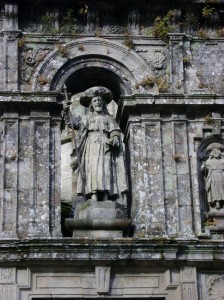 Although Santiago de Compostela has been associated with spirituality since olden times, it was the miraculous discovery of the remains of the apostle James in the ninth century in this area which made this Galician town so popular. These remains were buried in the site upon which the renowned cathedral of this town was later built.
Although Santiago de Compostela has been associated with spirituality since olden times, it was the miraculous discovery of the remains of the apostle James in the ninth century in this area which made this Galician town so popular. These remains were buried in the site upon which the renowned cathedral of this town was later built.“The authenticity of this legend has often created disputes in the Catholic Church since there are those who have their doubts about who is really buried in the crypt of this cathedral. Nevertheless, I believe that such controversy is superfluous because independently of who is buried within the silver box that lies at the heart of this holy site, the ultimate goal of each pilgrim is to stop there and meditate about the journey made and to liberate oneself from the troubling baggage of problems that one has carried along in order to come out as a new person.”
Thousands of pilgrims have walked this path for the last one thousand years and yet ‘the way’ is a very personal journey.
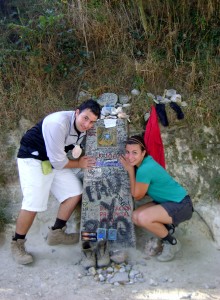 “I am a Catholic, however I am not a religious person. I must admit that my original aim for this walk was more based on cultural interest rather than a spiritual one. Yet such pilgrimages are full of surprises and my walk ended up giving me much more than that.”
“I am a Catholic, however I am not a religious person. I must admit that my original aim for this walk was more based on cultural interest rather than a spiritual one. Yet such pilgrimages are full of surprises and my walk ended up giving me much more than that.”The origin of such pilgrimages was generally based on sacrifice and repentance from one’s sins. Nowadays, things have changed and the aim for such an experience depends on each individual.
“This pilgrimage is not necessarily meant to be a sacrifice. One is not expected to suffer or to be in pain. I must say that today such a pilgrimage is more a reaction to that universal urge to leave the safety of home in order to find oneself. One has several options from where to start this pilgrimage and each have different levels of difficulties. The longest and most popular route is the Camino Francés which stretches 780 km from St. Jean-Pied-du-Port near Biarritz in France to Santiago.”
Matthew has participated two times in the Camino. The first time was 213 kms long, leaving from Ponferrada in Spain and taking 9 days to finish. The second one was 100 kms long, being the minimum distance, leaving from Sarria and taking 5 days to arrive to Santiago de Compostela.
 “Each time I went with a group of friends. The Camino we chose was not difficult and we walked about 20 to 25 kms daily. Friends provide good company and they also help you to go on whenever you might feel discouraged or tempted to stop. The walk was always deeply moving and enriching. Travelling on foot provides you with the leisure to look around you, to feel the earth beneath your feet, to breathe the fresh air and enjoy the various scents of the surrounding landscapes, and to listen to the sounds or relish the silence. It also presents you with those significant moments wherein you are walking alone thinking about your life, the decisions you made or are about to make, and the meaning of living itself. Although initially one might start this pilgrimage as a mere tourist, at the end of it one will recognize a considerable change in oneself.”
“Each time I went with a group of friends. The Camino we chose was not difficult and we walked about 20 to 25 kms daily. Friends provide good company and they also help you to go on whenever you might feel discouraged or tempted to stop. The walk was always deeply moving and enriching. Travelling on foot provides you with the leisure to look around you, to feel the earth beneath your feet, to breathe the fresh air and enjoy the various scents of the surrounding landscapes, and to listen to the sounds or relish the silence. It also presents you with those significant moments wherein you are walking alone thinking about your life, the decisions you made or are about to make, and the meaning of living itself. Although initially one might start this pilgrimage as a mere tourist, at the end of it one will recognize a considerable change in oneself.”During his research, Matthew discovered that even the kings of Spain participated in the Camino as part of an old tradition. Later on, during the walk he was informed that up to the present days, prisoners who have a good conduct are offered the opportunity to spend the last six months of their sentence walking the Camino with a guardian instead of spending them in prison.
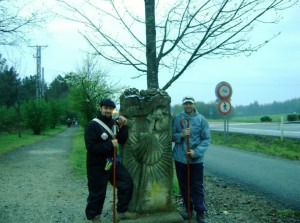 “You meet several people along this pilgrimage and you get the privilege to listen to their stories about why they chose to do this walk. Some of these narratives are very touching such as that of the Scandinavian eighty-year old man who had lost his wife some years before. As he walked part of the way with me, he told me how he had become very depressed by her death and had given up on life, waiting for his end to come soon. Then one day, he decided to stop mourning and to regain the joy of life again. After seeking help from a travel agency, he was recommended to try out the Camino and there he was seeking a way to turn a new page in his life.”
“You meet several people along this pilgrimage and you get the privilege to listen to their stories about why they chose to do this walk. Some of these narratives are very touching such as that of the Scandinavian eighty-year old man who had lost his wife some years before. As he walked part of the way with me, he told me how he had become very depressed by her death and had given up on life, waiting for his end to come soon. Then one day, he decided to stop mourning and to regain the joy of life again. After seeking help from a travel agency, he was recommended to try out the Camino and there he was seeking a way to turn a new page in his life.”One can choose the level of comfort and also the means how to do this pilgrimage. Hostels, hotels, restaurants, bars and shops are available all along the route which one can travel by walking, cycling, horse riding or even by car, although the latter does not count much.
 “When you decide which route you are going to take, you can buy a guidebook online and prepare your journey beforehand. These guidebooks will provide you with all the required information and also with recommendations where to stop. We used to start walking very early in the morning when it was still dark. After a 3km walk, we would stop to eat breakfast and then continue along the way for a further 17kms until we reached the next village or town, generally at around 12:30pm. We chose to rest at municipal hostels wherein we could take a shower, cook some food in the kitchen, wash our clothes and sleep in the dormitory for the price of 5 euros. Such an arrangement gave us the opportunity to visit the village or town in which we stopped or to eat a good meal at a restaurant whenever we felt like it.”
“When you decide which route you are going to take, you can buy a guidebook online and prepare your journey beforehand. These guidebooks will provide you with all the required information and also with recommendations where to stop. We used to start walking very early in the morning when it was still dark. After a 3km walk, we would stop to eat breakfast and then continue along the way for a further 17kms until we reached the next village or town, generally at around 12:30pm. We chose to rest at municipal hostels wherein we could take a shower, cook some food in the kitchen, wash our clothes and sleep in the dormitory for the price of 5 euros. Such an arrangement gave us the opportunity to visit the village or town in which we stopped or to eat a good meal at a restaurant whenever we felt like it.”“The secret is to travel as light as possible and to learn to live with the barest minimum. To cater for the changing weather, one should carry basic layering of clothing and everything should be waterproof. A first-aid kit which includes talc, cream against sores and adhesive bandages is a must. A torch is necessary to find the way in the dark. One must not forget to take any required medicine and also a medical prescription in case something happens to it. Ear plugs could be helpful when sleeping in dormitories. However one of the most important items is a comfortable and sturdy pair of shoes.”
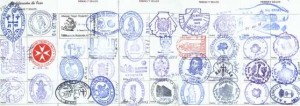 One should definitely not do this pilgrimage without carrying a pilgrim passport or credencial along with him.
One should definitely not do this pilgrimage without carrying a pilgrim passport or credencial along with him.“We obtained our credencial from the Curia of Madrid. This is a blank passport which one stamps along the way in order to confirm one’s participation in the pilgrimage. Many places are equipped with their unique Camino stamps along the route and we loved to go in search of the most appealing ones. When presented duly stamped at Santiago de Compostela, each pilgrim is given a certificate and a plenary indulgence. Eventually, this credencial becomes a very dear memento of this journey.”
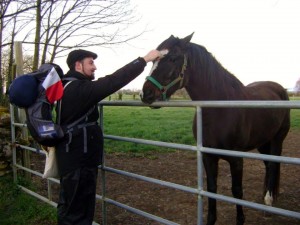 “Two other things which should be obtained before starting the walk is the pilgrims’ scallop shell and walking stick. We also placed a Maltese flag on our backpack and this was always a good conversation starter with other pilgrims. At the end of our pilgrimage, we made it a point to arrive in Santiago in time for the noon pilgrims’ mass where we received the blessing. Although we had walked for 20 kms, this experience was so uplifting and emotional that we felt no fatigue even though we had to stand up for an hour and a half as the cathedral was packed with people.”
“Two other things which should be obtained before starting the walk is the pilgrims’ scallop shell and walking stick. We also placed a Maltese flag on our backpack and this was always a good conversation starter with other pilgrims. At the end of our pilgrimage, we made it a point to arrive in Santiago in time for the noon pilgrims’ mass where we received the blessing. Although we had walked for 20 kms, this experience was so uplifting and emotional that we felt no fatigue even though we had to stand up for an hour and a half as the cathedral was packed with people.”Matthew’s first pilgrimage ended at Finisterre and the second at La Coruna.
 “Pilgrims used to walk another three to five days to reach the shores of Finisterre and Muxia, at the extreme point of Spain facing the Atlantic, the edge of the known world. There they would collect the scallop shells as a sign that they had walked the Camino. Legend has it that the body of St James was brought back from Jerusalem from these shores.”
“Pilgrims used to walk another three to five days to reach the shores of Finisterre and Muxia, at the extreme point of Spain facing the Atlantic, the edge of the known world. There they would collect the scallop shells as a sign that they had walked the Camino. Legend has it that the body of St James was brought back from Jerusalem from these shores.”“At Finisterre there is the tradition to throw away the walking stick which has accompanied you along your pilgrimage into the sea and then burn some of your clothes. This symbolically means that you have walked the way, that you have searched for answers and found them, and that now you are leaving the pilgrim’s life behind in order to go on with your life.”
(This article was published in the Travel Supplement issued with The Times of Malta dated 29th March 2017)
Category: Times of Malta | Tags: Atlantic,Biarritz,camino,Camino Francés,Cathedral of Portomarin,credencial,Finisterre,Fiona Vella,France,Holy Land,Knights Hospitallers of the Order of St John,Knights of St John,La Coruna,Matthias Ebejer,pilgrimage,Ponferrada,Santiago de Compostela,Spain,St James,St James’ Way,St. Jean-Pied-du-Port,the way